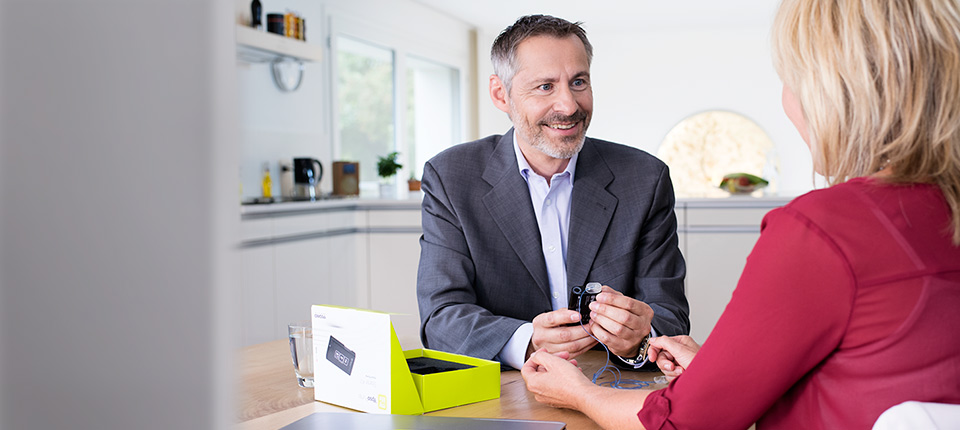
Coming to the AID of People with Diabetes
Connecting with diabetes partners to become part of an automated insulin delivery (AID) system.
Mar. 24, 2023
- Copy Link
- Share on X
- Share on Facebook
- Share on Linkedin
Connections.
They are at the core of most of the things we treasure in life. They are vital to establishing our families, friendships, work, intellectual pursuits and much more.
When the right ones are made, possibilities -- and even worlds -- expand, fueling progress and improving lives.
Providing AID Where Appropriate
Which is why we are establishing connections -- with companies and technologies -- that bring AID and convenience to those living with diabetes.
This is an important step to streamlining daily diabetes care. By connecting our integrated continuous glucose monitors (iCGMs) with other diabetes partners, to become an automated insulin delivery (AID) system, we’re giving people more time to spend living a happier and fuller life.
For years, managing diabetes involved frequent time- and thought-consuming tasks undertaken around the clock to ensure glucose levels were within acceptable ranges.
The introduction of iCGM systems, like FreeStyle Libre 2 and FreeStyle Libre 3, revolutionized testing, allowing users to get accurate glucose readings and trends without painful fingersticks.1 Unlike a blood glucose monitor reading, these systems capture and show additional data insights into where glucose levels were, are at currently, and where they are heading.
But what if that data were connected to an algorithm that determined how much insulin was needed? And then to an insulin pump that automatically delivered it in the background?
The more behind-the-scenes work done by innovative tech, the less hands-on involvement by people with diabetes who have many more interesting things to think about.
No more constant concern about checking numbers, figuring out insulin dosages and getting it onboard.
Such is the promise of integrating our FreeStyle Libre 2 and FreeStyle Libre 3 tech to become part of an AID system and taking the guess work out of insulin delivery.
What is an AID System?
Simply put, the AID system is made up of three connected technologies:
- An iCGM, like the FreeStyle Libre 2 or FreeStyle Libre 3, that continually tracks glucose levels and trending data.
- An insulin pump that administers the medication, when necessary, in appropriate dosages through a tiny catheter, inserted in the skin.
- An algorithm, which acts as the brain of the system, connecting the iCGM with the pump and automating the way they respond to each other based on the user’s glucose levels.
"Through the connected technology, this process goes on behind the scenes," said Dr. Mahmood Kazemi, Divisional Vice President, Global Medical & Scientific Affairs and Chief Medical Officer, Diabetes Care, Abbott. "The iCGM sends glucose levels to the insulin pump system, so it can send an appropriate amount of insulin to the individual, without them having to think about it all the time."
The Promise of Automated Insulin Delivery
Connecting these technologies will provide clear advantages to people living with diabetes, according to Dr. Kazemi.
"An AID system is considerably more convenient, as a person doesn't have to constantly check their glucose levels and calculate basal insulin dosages. Because the process is automatic and doesn't require constant attention, it saves them time and worry, not to mention it cares for the person even when they are asleep and unable to monitor their glucose levels or administer insulin.
"Clinical trials,2 using a variety of automated insulin delivery systems in children and adults, have consistently demonstrated improved glycemic control, evidenced by reduction in A1C, increased sensor time in target range, reduced glycemic variability, and reduction in hypoglycemia," said Dr. Kazemi.
The AID system can also decrease or suspend insulin administration to manage low blood glucose or increase insulin to manage hyperglycemia, important aspects of long-term diabetes management.
Making Diabetes Care Easier Around the World
Connecting these technologies is the future of diabetes care and indispensable to our goal of making diabetes management as easy as possible. By helping people remove as many mental, emotional and time concerns as possible, we are focused on bringing connected technology to people everywhere.
We recently partnered with Ypsomed and CamDiab to integrate our FreeStyle Libre 3 with their technology in Germany, with additional European countries to be announced this year.
"We'll provide the iCGM technology, and we’ll partner with companies that deliver insulin," said Dr. Kazemi. "We have a number of partners that will allow us to team up with leading insulin pump companies across the world to develop integrated solutions that streamline and improve daily diabetes management for people on insulin therapy."
In the United States, the FDA recently cleared our Freestyle Libre 2 and FreeStyle Libre 3 iCGM systems for AID integration, expanding our vision of helping people spend less time thinking about their diabetes and more time living productive lives.
As the future of diabetes care management both expands exponentially and becomes increasingly clear, we remain focused on developing and enhancing technologies that connect us with other innovators and the people who will most benefit from our combined efforts.
NOTE: FreeStyle Libre 3 integration with automated insulin deliver system mylife™ Loop (pictured above) available in Germany.
References
1 Fingersticks are required if your glucose alarms and readings do not match symptoms or when you see Check Blood Glucose symbol during the first twelve hours.
2 Berget C, Messer LH, Forlenza GP. A Clinical Overview of Insulin Pump Therapy for the Management of Diabetes: Past, Present, and Future of Intensive Therapy. Diabetes Spectr. 2019 Aug;32(3):194-204. doi: 10.2337/ds18-0091. PMID: 31462873; PMCID: PMC6695255.
Important Safety Information
FreeStyle Libre 2 and FreeStyle Libre 3 systems: Failure to use FreeStyle Libre 2 or FreeStyle Libre 3 systems as instructed in labeling may result in missing a severe low or high glucose event and/or making a treatment decision, resulting in injury. If glucose alarms and readings do not match symptoms or expectations, use a fingerstick value from a blood glucosemeter for treatment decisions. Seek medical attention when appropriate or contact Abbott at 855-632-8658 or FreeStyleLibre.us for safety info.
Related articles
-
Strategy and Strength
The Partnerships Changing How You Manage Diabetes
Abbott is connecting its tech with major insulin delivery systems, transforming the future of diabetes care.
For the latest on Abbott’s life-changing technology, get updates directly in your inbox.
